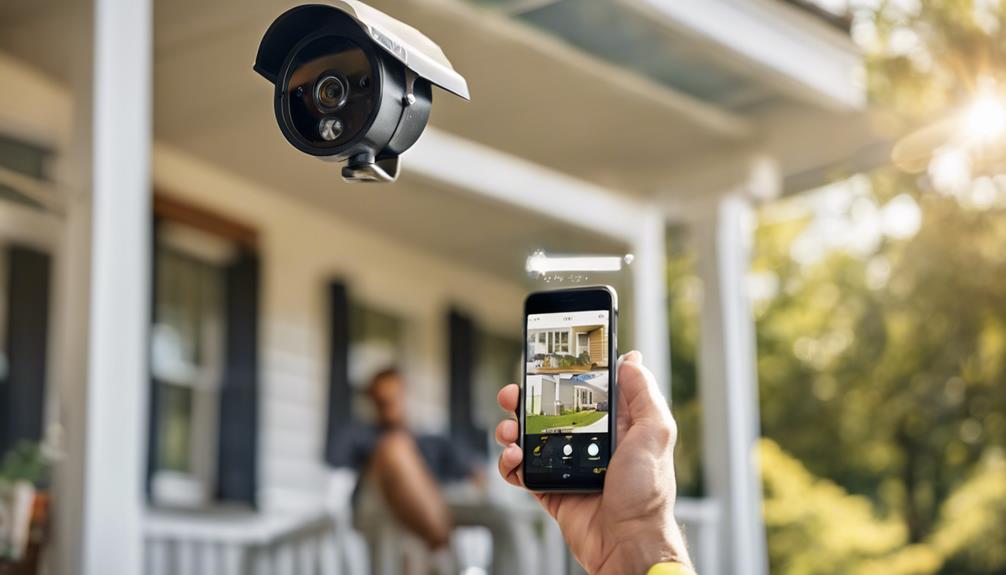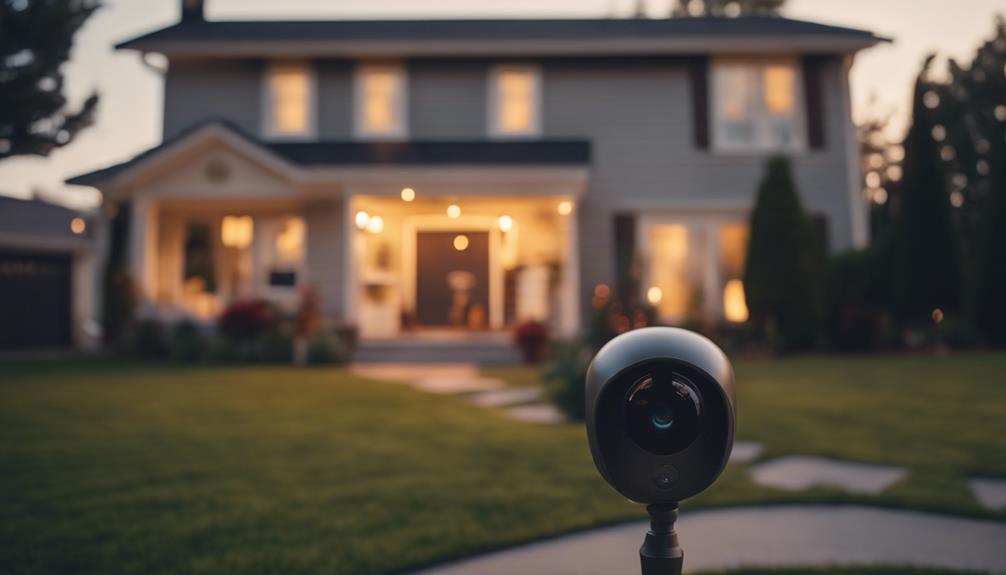Installing the Blink Home Security System is simple and user-friendly. First, download the Blink Home Monitor app to create your account and set up Multi-Factor Authentication for added security. Next, plug in the Sync Module near your Wi-Fi router, scan its QR code in the app, and connect it to your Wi-Fi. After that, insert batteries into your Blink camera and use the app to add the device by scanning the QR code found inside. Finally, mount the camera securely and adjust its angle for the best view. You'll find more details on optimizing your setup as you explore further.
Key Takeaways
- Download the Blink Home Monitor app to create and verify your Blink account with email and Multi-Factor Authentication for security.
- Plug the Sync Module into a wall outlet near your Wi-Fi router and connect it through the app by scanning the QR code.
- Insert two AA lithium batteries into your Blink camera, then use the app to add the camera by scanning its QR code.
- Choose a suitable mounting location for the camera within Wi-Fi range and securely attach it using the provided hardware.
Overview of Blink System
The Blink Home Security System is a versatile solution that combines a battery-powered outdoor camera with a Wi-Fi-connected Sync Module, guaranteeing reliable protection for your home.
With the Blink Outdoor Camera, you'll enjoy 1080p HD video quality, perfect for monitoring your property day or night. Its weather-resistant design means it can withstand various outdoor conditions, keeping you secure regardless of the elements.
For enhanced security, consider using a professional what to look for in a home cleaning service to maintain a clean environment around your premises, which can deter potential intruders.
Connecting the Blink system to your Wi-Fi network is easy, and the Blink app guides you through the setup process. You can adjust motion detection settings to suit your needs, making sure that you receive alerts only when necessary. The two-way audio feature adds a layer of convenience, allowing you to communicate with anyone near your camera directly through the app.
Additionally, the Sync Module offers you choices for video storage, whether you prefer cloud storage with subscription plans or local storage options. This flexibility guarantees that you can access your footage whenever you need it.
Creating Your Blink Account

To create your Blink account, start by downloading the Blink Home Monitor app and following the prompts.
As with setting up any new system, it's important to guarantee that your account is secure, so consider reviewing the simplicity of initiating blogging for tips on online safety.
You'll need to enter your email, choose a password, and verify your account via a code sent to your email.
Don't forget to set up Multi-Factor Authentication for added security.
Account Creation Process
Begin by downloading the Blink Home Monitor app from the App Store or Google Play, then follow the prompts to set up your account. To create a new Blink account, enter your country, region, email, and password.
Make certain to have the latest version of the Blink app, which is 33.1 for iOS and 33.0 for Android and Fire OS, to guarantee compatibility. Utilizing AI-driven solutions can enhance your security experience, as they often improve threat detection and response times, particularly in smart home technology AI in Cybersecurity.
Once you've entered your details, you'll need to complete the email verification process. Blink will send a PIN code to your email, which is valid for 40 minutes. Enter this code to verify your email address.
After that, you'll be prompted to verify your phone number through SMS or a voice call, enhancing your account's security.
For added functionality, you can choose to link your Blink account to your Amazon account. If you decide to do this, you'll need to provide your Amazon login credentials.
Remember that Multi-Factor Authentication (MFA) is essential for keeping your account secure, so follow all prompts carefully to guarantee your safety.
Multi-Factor Authentication Steps
Implementing Multi-Factor Authentication (MFA) adds an extra layer of security to your Blink account, guaranteeing that only you can access it. This process is particularly important given the rising concerns around electronic device security, similar to the Target Electronics Return Policy that emphasizes hassle-free customer service.
To complete this process, follow these steps:
- Create a new account: Download the Blink Home Monitor app and input your country, region, email, and password.
- Receive your verification email: After creating your account, you'll get a verification email with a PIN code. You need to enter this code within 40 minutes.
- Check for your PIN: If you don't receive the PIN code within 90 seconds, you can resend it to your email for verification.
- Verify your phone number: MFA requires you to verify your phone number through SMS or a voice call. This step guarantees that even if someone has your password, they can't access your account without your phone.
Once you've completed these steps, consider linking your Blink account to your Amazon account for added functionality. With MFA in place, you're taking an essential step in securing your home and information.
Setting Up the Sync Module

Plug the Sync Module into a wall outlet using the provided USB cable, placing it close to your Wi-Fi router for the best connection.
Once it's plugged in, open the Blink Home Monitor app on your smartphone. It's vital to guarantee a strong connection for peak battery life and performance of your cameras, similar to the emphasis on energy efficiency and ease of use in selected models for pool maintenance.
Tap the plus sign to begin, and select "Blink Wireless Camera System" from the options. You'll need to scan the QR code on the Sync Module or enter the serial number manually to add it to your system.
Wait a moment for the green light to turn on, along with the blue light blinking, which indicates that the Sync Module is ready to connect to your Wi-Fi network.
In the app, select your Wi-Fi network and enter the password. It's important to guarantee a strong connection for peak battery life and performance of your cameras.
After entering your Wi-Fi details, wait for the device update to complete. This process may take a few minutes, but it's significant for confirming everything is set up correctly.
Once the update finishes, you're ready to move on to the camera setup.
Adding Your Blink Camera

Now that you've set up your Sync Module and connected it to Wi-Fi, it's time to add your Blink camera.
Before you proceed, make certain that your home is equipped with proper audio-visual setup, as having a cohesive system can enhance your overall security experience, much like integrating home cinema systems into your entertainment space.
You'll need to prepare the camera by inserting batteries and using the Blink app to guide you through the process.
Let's get started on enhancing your home security with additional cameras.
Setting Up Sync Module
Setting up your Sync Module is essential for adding your Blink cameras and ensuring they function properly. Maintaining a secure home goes hand in hand with good habits, just like ensuring proper oral hygiene through methods like getting rid of plaque naturally. Follow these steps to get started:
- Open the Blink Home Monitor app: Tap the plus sign to select "Blink Wireless Camera System." Here, you can scan the QR code on the Sync Module or enter the serial number manually.
- Plug in your Sync Module: Use the provided USB cable to connect it to a wall outlet. Wait until the green light turns on and the blue light begins to blink—this indicates it's ready to connect.
- Connect to your Wi-Fi network: Select your Sync Module in the app and enter your Wi-Fi network password. Wait for the device update to complete.
- Add your Blink cameras: Follow the in-app instructions to scan the QR code located inside each camera's battery compartment.
Make sure your Sync Module is within range of your Wi-Fi router for peak performance. Once you've completed these steps, your Blink cameras will be ready to secure your home.
Connecting to Wi-Fi
With your Sync Module set up and connected to Wi-Fi, it's time to add your Blink camera to the network for seamless monitoring.
Start by removing the back cover of your Blink camera and inserting two AA lithium batteries to power it on.
Next, open the Blink app on your smartphone. Tap the plus sign (+) and select "Add Device." You'll need to scan the QR code located inside the battery compartment of your Blink camera, so hold your phone over it to capture the code.
Once the QR code is scanned, follow the in-app instructions to select your Wi-Fi network. Enter your Wi-Fi password when prompted. You'll know the connection is successful when you see a green light and a blue blinking light on the Sync Module.
After connecting, the Blink camera will automatically start a firmware update, ensuring it's running the latest software.
Once the update is complete, your Blink camera is now ready for monitoring through the Blink app, allowing you to keep an eye on your home from anywhere.
Adding Additional Cameras
To expand your security coverage, you can easily add additional Blink cameras to your existing system using the Blink Home Monitor app. Here's how to do it in just a few steps:
- Open the Blink Home Monitor app and tap "Add Device" from the Home screen.
- Select your camera model and either scan the QR code located inside the battery compartment or manually enter the camera's serial number.
- Power on the camera by inserting two AA lithium batteries and securely replacing the back cover.
- Receive notifications after successfully adding the camera, and access tips for ideal camera placement, including how to position a Blink camera outside for maximum effectiveness.
Once set up, your new camera will connect to the same Sync Module as your existing devices, allowing you to manage multiple cameras effortlessly.
You'll also start receiving motion detection alerts, enhancing your home security even further.
Adding additional Blink cameras is a straightforward process that considerably boosts your surveillance capabilities!
Mounting the Camera

Choosing the right location for your Blink camera is essential for effective monitoring and connectivity. Verify it's within range of your Wi-Fi signal and positioned to cover the area you want to monitor. Use the provided mounting hardware for installation, securely attaching the camera mount to a stable surface. For outdoor placements, remember to use screws to prevent detachment.
Here's a helpful table to visualize your options:
| Location Type | Pros | Cons |
|---|---|---|
| Indoors | Less exposure to elements | Limited view of outside |
| Outdoors | Wider coverage | Vulnerable to weather |
| Corners | Maximizes field of view | Might have obstructions |
| High Mounts | Reduces tampering risk | Harder access for adjustments |
After mounting, adjust the camera angle to capture the intended field of view. Avoid pointing it at areas with excessive movement to reduce false alerts. Test your placement by taking snapshots using the Blink app to confirm coverage before finalizing the installation. Don't forget to set up motion zones in the app afterward for enhanced monitoring.
Configuring Camera Settings

Configuring your Blink camera settings is essential for tailoring its performance to meet your specific security needs. With the right adjustments, you can enhance your home security effectively. Here are four key settings you'll want to customize:
- Motion Detection Sensitivity: Adjust this setting to determine how sensitive your camera is to movement. This helps reduce false alerts while guaranteeing you capture real activity.
- Recording Length: Set the duration for motion-triggered clips, with options ranging from 5 to 60 seconds. Choose a length that fits your monitoring needs.
- Motion Activity Zones: Use the Blink Home Monitor app to define specific areas of interest. This allows you to receive alert notifications only for movements in those zones.
- Camera Preferences: Schedule arming and disarming times for your system. This feature guarantees your camera is actively monitoring during times you specify.
Troubleshooting Common Issues

Even with the right camera settings in place, you might run into some common issues that can affect your Blink Home Security System's performance.
Start by checking if your Sync Module is powered and connected to Wi-Fi, as a stable connection is vital. If your camera is unresponsive, try restarting both the camera and the Blink app; this often resolves connectivity issues by clearing temporary glitches.
Make certain your camera is within range of the Wi-Fi signal. If the signal's weak, consider relocating the Sync Module or using a Wi-Fi extender to enhance coverage.
If you encounter error messages, don't panic. Simply refer to the Blink app's FAQ section for specific troubleshooting steps tailored to common issues related to setup and connectivity.
Additionally, regularly check for app updates to confirm you're using the latest version. Updates often include fixes for known problems and improvements in functionality, helping you avoid potential issues down the line.
Utilizing Storage Options

Blink cameras provide you with flexible storage options to guarantee your footage is safely saved and easily accessible. You can choose between cloud storage and local storage, making sure you find the best fit for your needs. Here are some key features to evaluate:
- Cloud Storage: With subscription plans, you can store your video clips securely in the cloud. New users can enjoy a free trial to test this service before committing.
- Local Storage: If you prefer to keep your footage on-site, the Sync Module allows you to save video clips locally.
- Additional Sync Modules: You can expand your local storage capacity by adding more Sync Modules, accommodating more cameras and video clips.
- Blink App Access: You can easily access and review your footage through the Blink app. Regularly check your storage status in the app to make sure you have enough space for new recordings, especially if you're using a free account.
Accessing Customer Support

To guarantee your Blink Home Security System runs smoothly, accessing customer support is key for resolving any issues you may encounter. Start by checking the Blink App and tapping into the thorough FAQ section, which provides troubleshooting tips for common issues. If you need further help, explore the dedicated support home on the official Blink website. Here, you'll find setup guides and instructional videos tailored to enhance your understanding of the system.
For unresolved issues, you can directly contact Blink customer support through the app or website for personalized assistance. Additionally, engaging in community forums can be beneficial. You can interact with other users, sharing experiences and tips about Blink products.
Here's a quick overview of the support options available:
| Support Option | Description |
|---|---|
| Blink App FAQ | Quick answers to common issues. |
| Troubleshooting Tips | Step-by-step solutions for specific problems. |
| Setup Guides | Detailed instructions for installation. |
| Community Forums | Connect with other users for shared advice. |
Utilizing these resources guarantees you get the most out of your Blink Home Security System.
Frequently Asked Questions
Is Blink Security Easy to Install?
Yes, Blink security's easy to install! You'll find the setup process straightforward, guided by the Blink app. Just follow the clear instructions, and you'll have your system up and running in no time. For those who want an even simpler installation process, consider the Simplisafe home security system installation. This system boasts an easy wireless setup, with no drilling or tools required. With just a few easy steps, you can have your entire home protected in no time.
How Do I Connect My Blink to My House?
To connect your Blink to your house, guarantee you have stable Wi-Fi. Download the app, plug in the Sync Module, and follow the prompts to add your cameras and secure them in place.
How Do I Install My Blink System?
Ever wondered how simple it can be to set up a security system? You'll start by downloading the app, connecting the Sync Module, inserting batteries, mounting the camera, and customizing your settings for ideal protection.
What Do I Need for a Blink Security System?
You'll need a Blink outdoor camera, a Sync Module, and a smartphone with the Blink Home Monitor app. Don't forget two AA lithium batteries per camera and a stable Wi-Fi network for ideal performance.
Conclusion
You've successfully set up your Blink home security system, and now you're ready to keep an eye on things.
With a few simple steps, you've turned your home into a fortress.
Just remember, when it comes to security, it's always better to be safe than sorry.
Don't hesitate to revisit the settings or reach out to customer support if you hit a snag.
Happy monitoring, and enjoy the peace of mind that comes with knowing you're protected!









